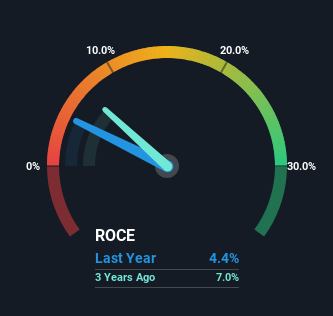- Israel
- /
- Food and Staples Retail
- /
- TASE:SAE
Returns On Capital Signal Tricky Times Ahead For Shufersal (TLV:SAE)
If you're not sure where to start when looking for the next multi-bagger, there are a few key trends you should keep an eye out for. Firstly, we'll want to see a proven return on capital employed (ROCE) that is increasing, and secondly, an expanding base of capital employed. Put simply, these types of businesses are compounding machines, meaning they are continually reinvesting their earnings at ever-higher rates of return. However, after investigating Shufersal (TLV:SAE), we don't think it's current trends fit the mold of a multi-bagger.
What Is Return On Capital Employed (ROCE)?
For those who don't know, ROCE is a measure of a company's yearly pre-tax profit (its return), relative to the capital employed in the business. Analysts use this formula to calculate it for Shufersal:
Return on Capital Employed = Earnings Before Interest and Tax (EBIT) ÷ (Total Assets - Current Liabilities)
0.044 = ₪467m ÷ (₪15b - ₪4.6b) (Based on the trailing twelve months to September 2023).
So, Shufersal has an ROCE of 4.4%. Ultimately, that's a low return and it under-performs the Consumer Retailing industry average of 7.8%.
See our latest analysis for Shufersal

Historical performance is a great place to start when researching a stock so above you can see the gauge for Shufersal's ROCE against it's prior returns. If you're interested in investigating Shufersal's past further, check out this free graph of past earnings, revenue and cash flow.
So How Is Shufersal's ROCE Trending?
In terms of Shufersal's historical ROCE movements, the trend isn't fantastic. To be more specific, ROCE has fallen from 9.7% over the last five years. On the other hand, the company has been employing more capital without a corresponding improvement in sales in the last year, which could suggest these investments are longer term plays. It's worth keeping an eye on the company's earnings from here on to see if these investments do end up contributing to the bottom line.
On a related note, Shufersal has decreased its current liabilities to 30% of total assets. So we could link some of this to the decrease in ROCE. Effectively this means their suppliers or short-term creditors are funding less of the business, which reduces some elements of risk. Since the business is basically funding more of its operations with it's own money, you could argue this has made the business less efficient at generating ROCE.
The Bottom Line
To conclude, we've found that Shufersal is reinvesting in the business, but returns have been falling. Additionally, the stock's total return to shareholders over the last five years has been flat, which isn't too surprising. In any case, the stock doesn't have these traits of a multi-bagger discussed above, so if that's what you're looking for, we think you'd have more luck elsewhere.
One more thing: We've identified 2 warning signs with Shufersal (at least 1 which is concerning) , and understanding them would certainly be useful.
While Shufersal may not currently earn the highest returns, we've compiled a list of companies that currently earn more than 25% return on equity. Check out this free list here.
New: Manage All Your Stock Portfolios in One Place
We've created the ultimate portfolio companion for stock investors, and it's free.
• Connect an unlimited number of Portfolios and see your total in one currency
• Be alerted to new Warning Signs or Risks via email or mobile
• Track the Fair Value of your stocks
Have feedback on this article? Concerned about the content? Get in touch with us directly. Alternatively, email editorial-team (at) simplywallst.com.
This article by Simply Wall St is general in nature. We provide commentary based on historical data and analyst forecasts only using an unbiased methodology and our articles are not intended to be financial advice. It does not constitute a recommendation to buy or sell any stock, and does not take account of your objectives, or your financial situation. We aim to bring you long-term focused analysis driven by fundamental data. Note that our analysis may not factor in the latest price-sensitive company announcements or qualitative material. Simply Wall St has no position in any stocks mentioned.
About TASE:SAE
Shufersal
Operates a chain of supermarkets under the Shufersal brand name in Israel.
Solid track record, good value and pays a dividend.
Market Insights
Community Narratives



